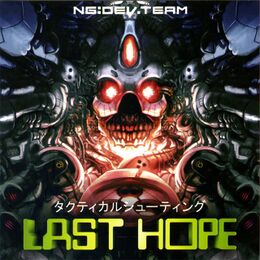Difference between revisions of "Independently Developed Dreamcast Games"
From Sega Retro
NiktheGreek (talk | contribs) (There is so much wrong with this page, but I've wiped out the worst of the factual errors.) |
|||
| Line 1: | Line 1: | ||
[[File:LastHope Box Front.jpg|thumb|260px|2007's ''[[Last Hope]]'' was marketed as being "the last Dreamcast game"... before others were announced.]] | [[File:LastHope Box Front.jpg|thumb|260px|2007's ''[[Last Hope]]'' was marketed as being "the last Dreamcast game"... before others were announced.]] | ||
| − | The [[Sega Dreamcast]] has been pronounced "dead" several times. | + | The [[Sega Dreamcast]] has been pronounced "dead" several times. Console production was officially discontinued in 2001, and game releases in North America and Europe ground to a halt in 2002. Japan held out much longer with official releases continuing for some time, slowing to a trickle in 2005 and finally ceasing with [[Milestone]]'s ''[[Karous]]'' in 2007. |
| − | But support for the console has never faded away completely thanks to | + | But support for the console has never faded away completely thanks to independent developers and publishers. To this day there are Dreamcast games in development, meaning its lifespan has technically surpassed the [[Nintendo GameCube]] and [[Microsoft Xbox]] - the consoles that are said to have caused Sega to pull out of the manufacturing business. |
Independant games for the Dreamcast can exist as most Dreamcast models are able to boot compact discs using the [[Mil-CD]] format. Official games used [[GD-ROM]]s, a proprietary optical disc format which allows for more storage space than a typical CD-ROM (and is more secure), but as a Dreamcast can run CD-Rs without the need for extra modifications (unlike consoles both before and after), it is a popular platform for homebrew and independant development. | Independant games for the Dreamcast can exist as most Dreamcast models are able to boot compact discs using the [[Mil-CD]] format. Official games used [[GD-ROM]]s, a proprietary optical disc format which allows for more storage space than a typical CD-ROM (and is more secure), but as a Dreamcast can run CD-Rs without the need for extra modifications (unlike consoles both before and after), it is a popular platform for homebrew and independant development. | ||
Revision as of 11:56, 9 December 2010

The Sega Dreamcast has been pronounced "dead" several times. Console production was officially discontinued in 2001, and game releases in North America and Europe ground to a halt in 2002. Japan held out much longer with official releases continuing for some time, slowing to a trickle in 2005 and finally ceasing with Milestone's Karous in 2007.
But support for the console has never faded away completely thanks to independent developers and publishers. To this day there are Dreamcast games in development, meaning its lifespan has technically surpassed the Nintendo GameCube and Microsoft Xbox - the consoles that are said to have caused Sega to pull out of the manufacturing business.
Independant games for the Dreamcast can exist as most Dreamcast models are able to boot compact discs using the Mil-CD format. Official games used GD-ROMs, a proprietary optical disc format which allows for more storage space than a typical CD-ROM (and is more secure), but as a Dreamcast can run CD-Rs without the need for extra modifications (unlike consoles both before and after), it is a popular platform for homebrew and independant development.
The first widely accepted independant Dreamcast games are those in the bleemcast! series. Newer games are typically region-free, and are usually sold via online stores such as Play Asia. As the games are not usually backed by Sega, packaging and box designs are largely inconsistent, with newer games often being packaged in DVD boxes (following the example set by Karous) as a result.
List of Games
- bleemcast! (2001)
- DreamParaPara (2001)
- Feet of Fury (2003)
- Cool Herders (2005)
- Inhabitants (2005)
- Maqiupai (2005)
- Last Hope (2007)
- Wind and Water: Puzzle Battles (2008)
- DUX (2009)
- Rush Rush Rally Racing (2009)
- Irides: Master of Blocks (2009)
- Last Hope: Pink Bullets (2009)
- Fast Striker (2010)